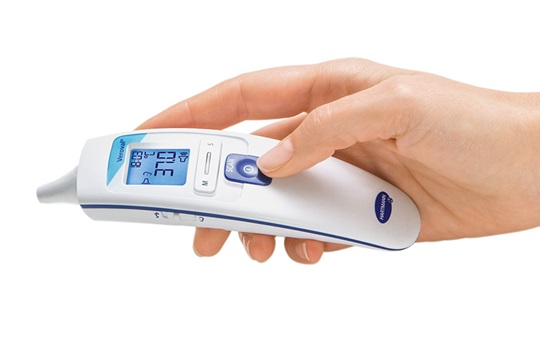Infrared thermometers - why they are the product of choice for the whole family


The body temperature naturally fluctuates throughout the day. For example, the body temperature is a little higher in the evening than in the morning. The human body regulates the body temperature to a target value, although body temperature can fluctuate by up to 1 °C over the course of a day. Throughout the course of life, your average body temperature can decrease by up to 0.5 °C. Moreover, the temperature inside the body (core temperature) and the surface temperature on the skin have different values. Thus, there is no ‘normal’ body temperature – it always depends on the measurement site.
| Measurement site | |||
| Description | Ear / forehead | Rectum | Mouth / armpit |
| Subnormal temperature | <35.7 | <36.2 | <35.8 |
| Normal temperature | 35.8 - 36.9 | 36.3 - 37.4 | 35.9 - 37.0 |
| Elevated temperature | 37.0 - 37.5 | 37.5 - 38.0 | 37.1 - 37.5 |
| Slight fever | 37.6 - 38.0 | 38.1 - 38.5 | 37.6 - 38.0 |
| Moderate fever | 38.1 - 38.5 | 38.6 - 39.0 | 38.1 - 38.5 |
| High fever | 38.6 - 39.4 | 39.1 - 39.9 | 38.6 - 39.5 |
| Very high fever | 39.5 - 42.0 | 40.0 - 42.5 | 39.6 - 42.0 |
What causes fever?
Usual symptoms of fever are:
However, note that not all of the symptoms listed above occur or appear at the same time.
Detection of fever
Taking the temperature with a thermometer is the most efficient and reliable way for you to detect fever.
Your body adjusts its temperature in order to create the ideal environment for vital procedures such as the enzymatic reactions of the metabolism (enzymes need a certain surrounding temperature in order to function). Because of this, the body temperature varies up to 1 °C throughout the day. In addition, the temperature within the body (core temperature) and the surface temperature of the skin show great differences. For this reason, there is no general “normal” body temperature. As a rule, your body temperature always depends on the measurement site and is also influenced by the ambient temperature, your age, stress levels, duration of sleep, hormone levels and physical activity.
While glass and digital thermometers measure the temperature of the human body directly, ear and forehead measurement involves determining the core body temperature using the infrared radiation emitted by the body. Even when the temperature is measured correctly, the reading can differ slightly from a rectal, oral or axillary temperature measurement obtained using a digital thermometer.
Why is fever important for people who suffer from an illness?
Fever is a common response to infection in the body, it can help fight infection. The term denotes an elevated temperature of the human body that is substantially beyond the normal range. The presence of a fever is usually related to stimulation of the body's immune response. Fever can support the function of the immune system against infectious agents such as viruses and bacteria and can make it difficult for temperature-sensitive viruses and bacteria to reproduce themselves.
